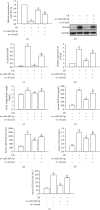The Effect of miR-505-5p on Inhibition of Serum Uromodulin Ameliorates Myocardial Inflammation and Apoptosis Induced by Ischemia-Reperfusion
- PMID: 36225178
- PMCID: PMC9550459
- DOI: 10.1155/2022/3521971
The Effect of miR-505-5p on Inhibition of Serum Uromodulin Ameliorates Myocardial Inflammation and Apoptosis Induced by Ischemia-Reperfusion
Abstract
Background: It has been found that miR-505-5p is closely related to cardiovascular metabolic risk factors. Nonetheless, there is little research analyzing miR-505-5p for its role as well as molecular mechanism in myocardial injury caused by ischemia-reperfusion (I/R).
Methods: This work utilized quantitative reverse transcriptase PCR (qRT-PCR) for detecting miR-505-5p and serum uromodulin (sUmod) levels. sUmod, interleukin-1beta (IL-1β), IL-6, IL-10, caspase7, caspase9, tumor necrosis factor-alpha (TNF-α), Bax, and Bcl-xL expression was detected by western blot. Bioinformatics database was used for target prediction and miR-505-5's target was determined by luciferase reporter gene assay.
Results: Relative to sham group, sUmod was highly expressed within myocardial I/R injury (MIRI), whereas sUmod silencing significantly decreased the heart weight/body weight ratio, reduced serum myocardial enzymes expression, ameliorated I/R-mediated myocardial apoptosis, and inflammation. TargetScan bioinformatics database and luciferase reporter genes confirmed that sUmod was miR-505-5p's direct target gene, besides, miR-505-5p overexpression significantly improved the myocardial injury score, increased IL-10, decreased TNF-α, IL-1β, IL-6 expression, decreased caspase7, caspase9, Bax expression, and increased Bcl-xL expression. More importantly, overexpression of sUmod abolished miR-505-5p overexpression's role in I/R-mediated myocardial apoptosis and inflammation.
Conclusion: miR-505-5p can improve I/R-mediated myocardial apoptosis and inflammation by targeting sUmod. In this study, miR-505-5p is related to MIRI pathogenesis, which provides the new possible targeted therapy in patients with MIRI.
Copyright © 2022 Dongsheng He et al.
Conflict of interest statement
All authors declare no competing interest.
Figures





Similar articles
-
Effects of miR-145-5p on cardiomyocyte proliferation and apoptosis, GIGYF1 expression and oxidative stress response in rats with myocardial ischemia-reperfusion.Cell Mol Biol (Noisy-le-grand). 2022 May 22;68(1):147-159. doi: 10.14715/cmb/2022.68.1.19. Cell Mol Biol (Noisy-le-grand). 2022. PMID: 35809317
-
LncRNA Rian reduces cardiomyocyte pyroptosis and alleviates myocardial ischemia-reperfusion injury by regulating by the miR-17-5p/CCND1 axis.Hypertens Res. 2022 Jun;45(6):976-989. doi: 10.1038/s41440-022-00884-6. Epub 2022 Mar 9. Hypertens Res. 2022. PMID: 35264782
-
Inhibition of miR-218-5p reduces myocardial ischemia-reperfusion injury in a Sprague-Dawley rat model by reducing oxidative stress and inflammation through MEF2C/NF-κB pathway.Int Immunopharmacol. 2021 Dec;101(Pt B):108299. doi: 10.1016/j.intimp.2021.108299. Epub 2021 Nov 5. Int Immunopharmacol. 2021. PMID: 34749249
-
Silencing of Long noncoding RNA SOX2-OT relieves myocardial ischemia/reperfusion injury through up-regulating microRNA-146a-5p.Bratisl Lek Listy. 2023;124(2):143-150. doi: 10.4149/BLL_2023_022. Bratisl Lek Listy. 2023. PMID: 36598302
-
Long non-coding RNA growth arrest specific transcript 5 acting as a sponge of MicroRNA-188-5p to regulate SMAD family member 2 expression promotes myocardial ischemia-reperfusion injury.Bioengineered. 2021 Dec;12(1):6674-6686. doi: 10.1080/21655979.2021.1957524. Bioengineered. 2021. PMID: 34632932 Free PMC article.
Cited by
-
HTK vs. HTK-N for Coronary Endothelial Protection during Hypothermic, Oxygenated Perfusion of Hearts Donated after Circulatory Death.Int J Mol Sci. 2024 Feb 13;25(4):2262. doi: 10.3390/ijms25042262. Int J Mol Sci. 2024. PMID: 38396938 Free PMC article.
References
-
- Yu L.-M., Dong X., Xue X.-D., et al. Melatonin attenuates diabetic cardiomyopathy and reduces myocardial vulnerability to ischemia-reperfusion injury by improving mitochondrial quality control: role of SIRT6. Journal of Pineal Research . 2021;70(1, article e12698) doi: 10.1111/jpi.12698. - DOI - PubMed
MeSH terms
Substances
LinkOut - more resources
Full Text Sources
Research Materials

